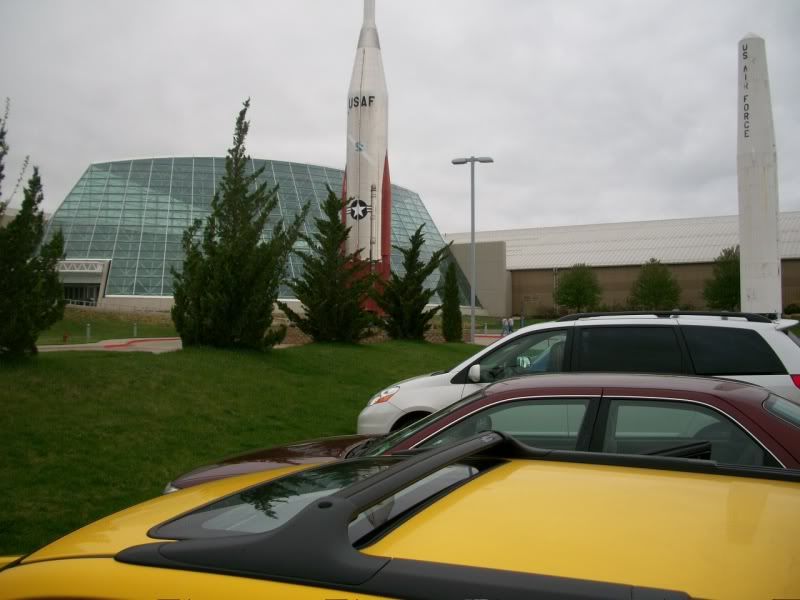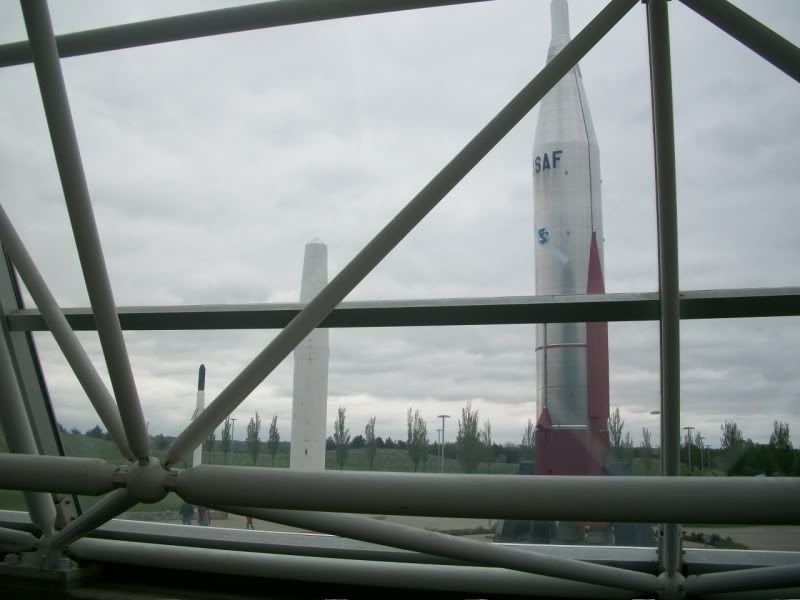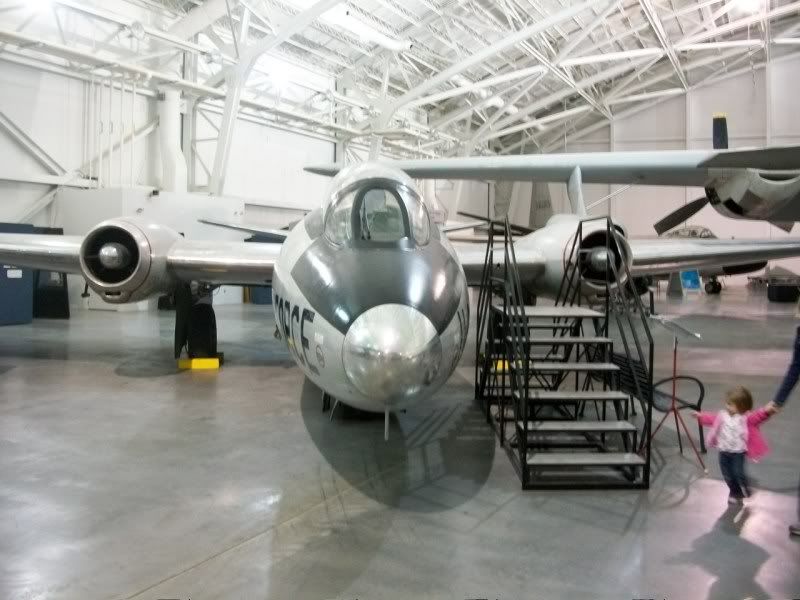WE GOT WORMS
I started to try and explain why this was so funny to us, but I do realize the inherent futility of such an attempt so I'll leave it at that; needless to say variations on the theme kept us entertained for longer than it probably warranted. There was also a large flatbed truck carrying hundreds of sacks of something called "HOLEPLUG" which we found a little bit amusing for various off-colour reasons. Found out later it is a Halliburton product used in the field of...errr, drilling. Oh, and close to home, we saw a sign saying "Auto Repair $29.99" which struck us as perhaps maybe a good deal, if anyone is in need of automotive repair, ANY automotive repair...always $29.99!
Enough of this silly reminiscing of our roadtrippery, on to the museum:

Out front they had what I had assumed were NASA rockets, but I was rather amazed to see were ballistic missiles, the largest a true ICBM (intercontinental range), from the Atlas series. The sheer imposing bulk of the Atlas was stunning, like a monstrous flying tower. The idea that these gargantuan rockets were ready to launch into suborbital space, traverse the globe, and rain nuclear hell upon our old adversaries is something often lost to memory decades after the Cold War. Here's another picture of them from inside the building:

In the main lobby, they have a uniquely artistic display of a decommissioned SR-71 Blackbird, a somewhat wicked looking spy plane whose primary anti-missile defense was to simply hit the gas and outrun the missiles. Fastest production jet, ever. Size here is hard to gather from a picture, but suffice to say that this is a sizable aircraft!

Here is the view of the first hangar. A B-17 Flying Fortress has the honored position in the foreground center, somewhat dwarfed by the B-52 in the background. At the very back is the B-36, with six rear facing prop engines.

Forgive the poor quality of some of these shots, the somewhat low lighting required longer exposures and blurrier image quality. This is a U-2 spy plane, made famous when the Rooskies shot down Gary Powers in one in 1960. It's amazing that there are still 35 of these in active duty with the USAF.

The B-17, the workhorse of the Army Air Corps in bombing the excrement out of Nazi Germany, is a beautiful plane. Bristling with .50 caliber machine guns in every direction, and generally a stable and trusted plane.

My grandfather manned the waist gunner position, shown here, during many missions over Europe.

The B-36 was one of our first nuke-ferriers comprising our nuclear deterrent after WWII. As I recall it has the widest wingspan of any combat aircraft. Despite the goofy bug-like looks of the cockpit it is an impressive looking plane. I stood in one of the bomb bays and took a picture, but the low light didn't convey how cavernous it actually was. I would love to do a walkthrough of such an aircraft someday.

The B-47 was a precursor to the B-52, giving us a serious jet bomber that could penetrate Russian air defenses in the early Cold War. Another bug-like cupola ensures this one won't win any beauty competitions...not that you could tell anyway due to the poor quality photo!

The B-25 Mitchell was a sort of all-purpose utility bomber in WWII, not the big, unmanouverable heavy bomber sort like the B-17 and B-29 (the latter was not on exhibit but was undergoing restoration in the second hangar). This was a nice one on exhibit here:

The A-26 is similar sort of "attack" aircraft used for light bombing roles.

Here's my daughter straining to approach a B-57, a Korean War era light bomber.

Hiding in the corner, a reconnoissance-tasked RB-45; the B-45 was America's first operational jet bomber.

A supersonic strategic bomber variant of the F-111 fighter, this swept-wing beauty didn't come out well in the photos.

An F-4 Phantom adapted for recon work:

Now this one was well worth the trip...one of two XF-85 prototypes ever built. A clever idea that was probably a bit too clever, it was designed to fit in one of the bomb bays of the slow, giant B-36 bombers, and be dispatched to deal with interceptors in the same way Imperial Star Destroyers launch TIE fighters, since fighter escorts could not easily accompany a heavy bomber over intercontinental ranges. The thing is quite funny to look at, and is quite small. The problems that led to its cancellation was a difficulty in reconnecting to the carrier craft (see the hook in the nose).

"Now then Dimitri. You know how we've always talked about the possibility of something going wrong with the bomb. The bomb, Dimitri. The hydrogen bomb." And here one is:

What I found particularly amusing was the writing on the bomb itself. First off, this is a nuclear bomb. You would think they might proofread the instructions they stamp on it for typos, or at least make an "ATTEMP" at doing so. And then the inherent vagueness. "FOR STRIKE" followed with two steps. For strike? Can't we use complete sentences? You don't need to skimp for pennies by using less ink, I mean, really! Happily I can report that I refrained from ATTEMPING to remove the arming rods.

On to the other hangar! First a couple early model helicopters, an H-19:

And a CH-21 which looks like a precursor to the CH-47 Chinook (and from some reading it sounds like the same designers were involved):

Gretchen had fun with this thing:

They had an Avro Vulcan there, basically a flying triangle. One of Britain's nuclear deterrant bombers.

Quite a beautiful (and large) bird:

The highlight of this hangar is the B-1A on display. A supersonic swept wing bomber, I just have to say this thing is huger than one expects.

Another fun bit were some of the inert nuclear warheads and the ballistic missile control systems on display. These are some seriously antiquated machines!

Look, it's Eddie the Shipboard Computer!

These systems are thoroughly hardware based. I would love to get a screwdriver and peek around at their innards.

This is an ICBM control panel. There are a few too many buttons for malfunctions on it for my comfort! They should add "TROUBLE TEST" as a key for standard QWERTY keyboards.

The DC-3 was probably the primary ferrier for paratroopers in WWII. Analagous to the UH-1 Huey in Vietnam, it was a troop mover.

On one side of this door was the interior of a transport plane and on the other side was the flak-filled air thousands of feet over France, amazing how these men just jumped through there. A moving account, if you can find it, is "Those Devils in Baggy Pants", of which I've read a number of excerpts.

Gretchen, of course, rode 200 miles for soft blocks. I love how they make a toddler area complete with an open electrical socket at the perfect height for them!

But alas it was nearing meltdown time. This last shot was taken with Gretchen straining in my arms and rather upset. Came out well though.
